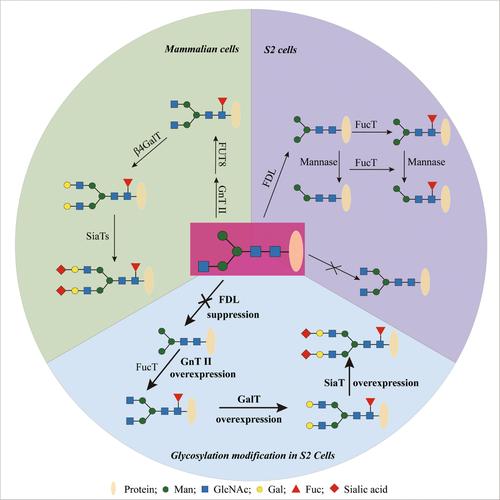当前位置:
X-MOL 学术
›
Biotechnol. Bioeng.
›
论文详情
Our official English website, www.x-mol.net, welcomes your
feedback! (Note: you will need to create a separate account there.)
Glycosylation in Drosophila S2 cells
Biotechnology and Bioengineering ( IF 3.5 ) Pub Date : 2024-08-14 , DOI: 10.1002/bit.28827 Tingting Xu 1 , Lixiang Tong 1 , Zhifu Zhang 1 , Hairong Zhou 1 , Peilin Zheng 1
Biotechnology and Bioengineering ( IF 3.5 ) Pub Date : 2024-08-14 , DOI: 10.1002/bit.28827 Tingting Xu 1 , Lixiang Tong 1 , Zhifu Zhang 1 , Hairong Zhou 1 , Peilin Zheng 1
Affiliation

|
In recent years, there has been a remarkable surge in the approval of therapeutic protein drugs, particularly recombinant glycoproteins. Drosophila melanogaster S2 cells have become an appealing platform for the production of recombinant proteins due to their simplicity and low cost in cell culture. However, a significant limitation associated with using the S2 cell expression system is its propensity to introduce simple paucimannosidic glycosylation structures, which differs from that in the mammalian expression system. It is well established that the glycosylation patterns of glycoproteins have a profound impact on the physicochemical properties, bioactivity, and immunogenicity. Therefore, understanding the mechanisms behind these glycosylation modifications and implementing measures to address it has become a subject of considerable interest. This review aims to comprehensively summarize recent advancements in glycosylation modification in S2 cells, with a particular focus on comparing the glycosylation patterns among S2, other insect cells, and mammalian cells, as well as developing strategies for altering the glycosylation patterns of recombinant glycoproteins.
中文翻译:

果蝇 S2 细胞中的糖基化
近年来,治疗性蛋白质药物,尤其是重组糖蛋白的批准出现了显著的激增。果蝇S2 细胞因其在细胞培养中的简单性和低成本而成为生产重组蛋白的有吸引力的平台。然而,与使用 S2 细胞表达系统相关的一个重大限制是它倾向于引入简单的多甘露糖基化结构,这与哺乳动物表达系统中的结构不同。众所周知,糖蛋白的糖基化模式对物理化学性质、生物活性和免疫原性有深远影响。因此,了解这些糖基化修饰背后的机制并实施措施来解决它已成为一个相当有趣的主题。本文旨在全面总结S2细胞糖基化修饰的最新进展,特别关注比较S2、其他昆虫细胞和哺乳动物细胞之间的糖基化模式,以及开发改变重组糖蛋白糖基化模式的策略。
更新日期:2024-08-14
中文翻译:

果蝇 S2 细胞中的糖基化
近年来,治疗性蛋白质药物,尤其是重组糖蛋白的批准出现了显著的激增。果蝇S2 细胞因其在细胞培养中的简单性和低成本而成为生产重组蛋白的有吸引力的平台。然而,与使用 S2 细胞表达系统相关的一个重大限制是它倾向于引入简单的多甘露糖基化结构,这与哺乳动物表达系统中的结构不同。众所周知,糖蛋白的糖基化模式对物理化学性质、生物活性和免疫原性有深远影响。因此,了解这些糖基化修饰背后的机制并实施措施来解决它已成为一个相当有趣的主题。本文旨在全面总结S2细胞糖基化修饰的最新进展,特别关注比较S2、其他昆虫细胞和哺乳动物细胞之间的糖基化模式,以及开发改变重组糖蛋白糖基化模式的策略。


















































 京公网安备 11010802027423号
京公网安备 11010802027423号